American Indian Fetishes
Known around the world for their work, Zuni people have traditionally used small stone carvings of animal figures as power objects and mediators. The body of the fetish can be shaped of bone, shell, clay, stone or other materials. The polished and carved stones can be found in the shape of eagles, bears, mountain lions, wolves, rabbits, fish, badgers, snakes, falcons and corn maidens, among others.
Source: Heard Museum
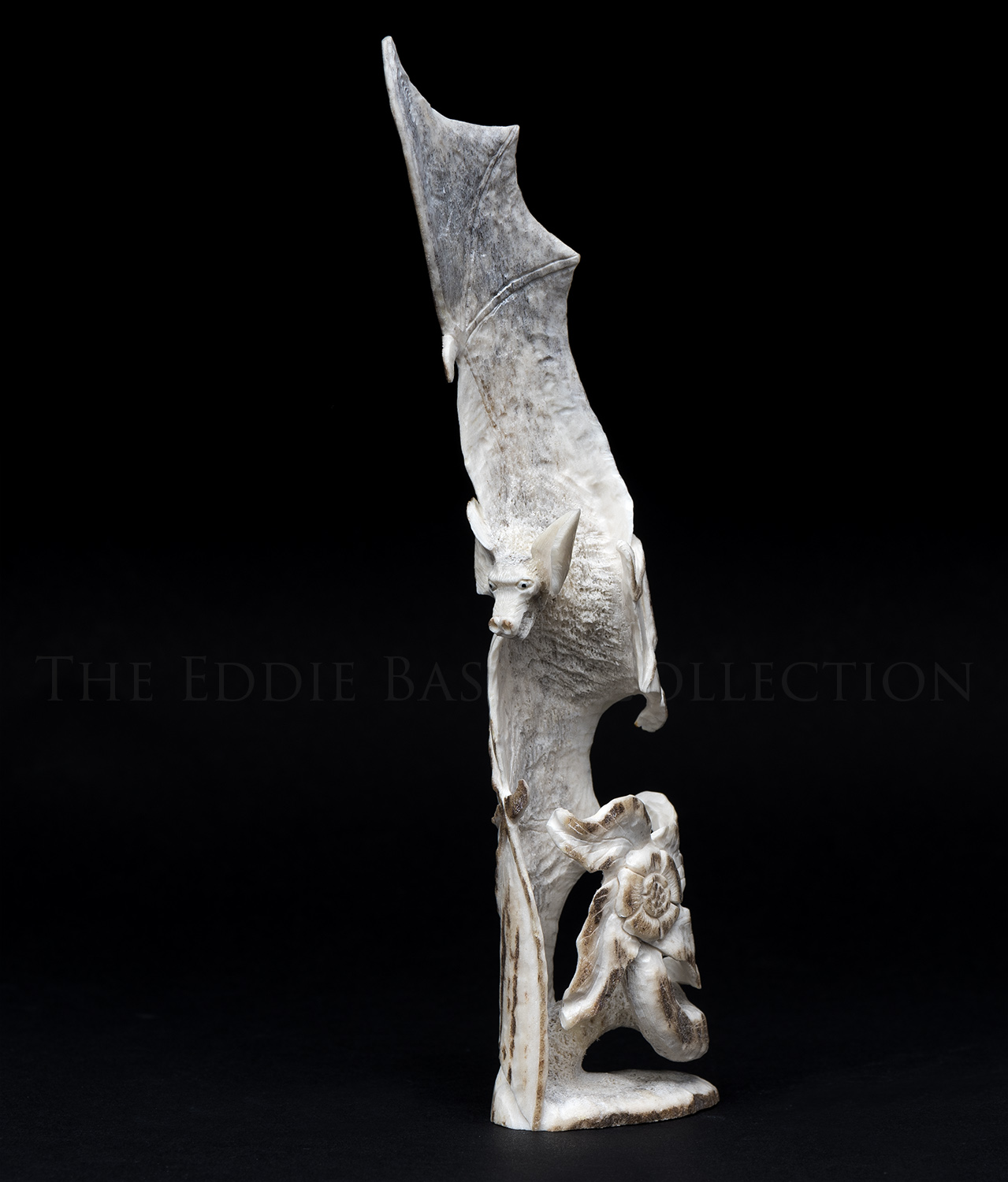
Bat Fetish | Lewis Malie
Artist: American Indian Fetishes
Description: Antler Carving | 7 ¾”h x 1 ¾”w x 1”dsculpture
Carved from antler, the bat is known as being the guardian of the night, the cleaner, in Zuni culture.
Zuni Maiden | Faye Quandelacy (1958-2022)
Artist: American Indian Fetishes
Description: Amber | Dimensions: 3”hsculpture
Faye Quandelacy, the internationally renowned Zuni fetish carver who graduated from the Institute of American Indian Arts in Santa Fe where she studied under Allan Houser, passed away September 2022. Quandelacy is credited for pioneering a very unique style of maiden carvings such as the beautiful amber piece shown here. Faye passed on her many gifts to her daughter just as her Mother, Ellen Quandelacy, passed on her gifts to Faye.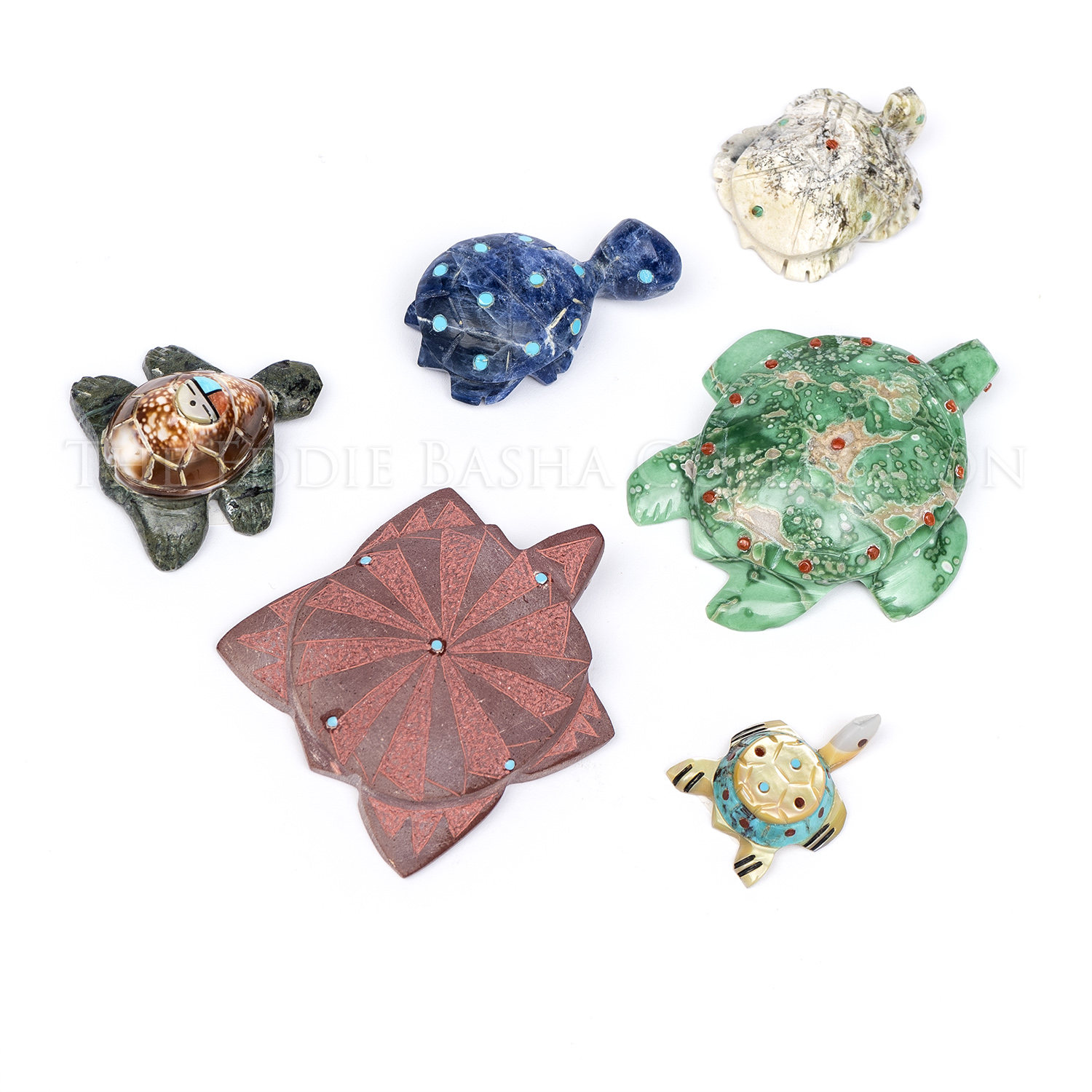
Zuni Turtle Fetish | Various Artists
Artist: American Indian Fetishes
Description: The turtle fetish, a symbol of Mother Earth, is one of the most frequently carved Zuni fetishes. It serves as a link to Zuni ancestors and is associated with longevity, tenacity and self-reliance.sculpture
The names of the carvers and the materials used pictured here are as follows beginning at the center top, then rotating clockwise:
Loren Burns: Lapis (Blue) Turtle
Carl Etsate: Serpentine Turtle
Chris Huselew: Varasite (Green) Turtle
Loren Burns: Mother of Pearl & Turquoise Mop Turtle
Brandon Phillips: Pipestone Etched Turtle
Fabian Homer: Cowrie Shell & Marble Turtle with Zuni Sun Face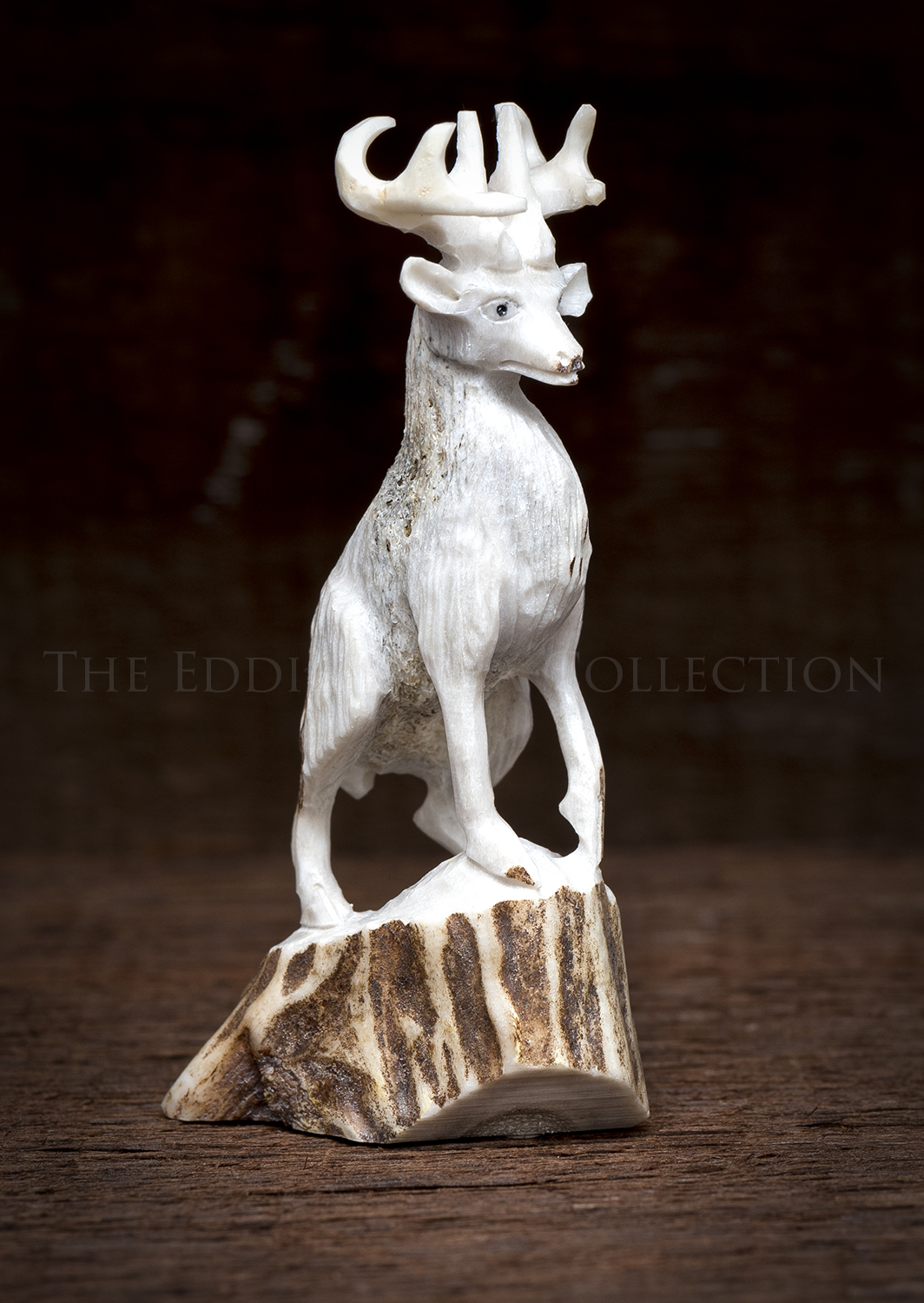
Deer Fetish | Pernell Laate (d.2008)
Artist: American Indian Fetishes
Description: Deer Antler | Dimensions: 2 ½”h x 2 ½”wsculpture
In Zuni culture, deer represent gentleness, compassion and kindness and though deer are less commonly carved, they are often depicted with a fair amount of attention to detail and carved in deer antler as is the case here. This particular fetish was carved by the late Pernell Laate who was a wonderful Zuni carver of human figures, birds and other animal fetishes. He often used antler and fossilized ivory to create intricate and delicate carvings. Pernell began carving in the middle 1980s along with his brother, Max Pernell.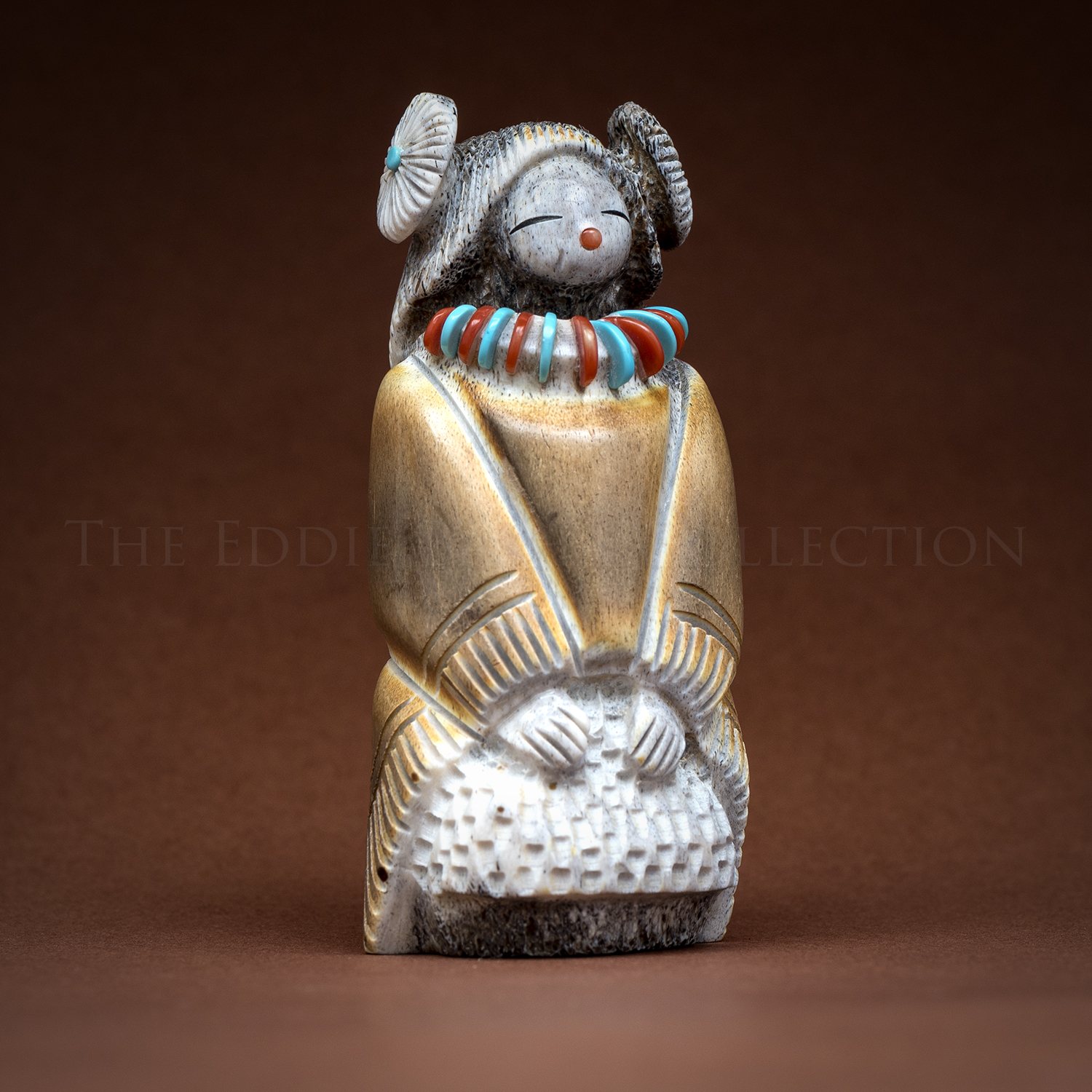
Robed Hopi Maiden | Claudia Peina
Artist: American Indian Fetishes
Description: Elk Antler, turquoise & coral | Dimensions: 2 ¾”h x 1 ½”w x 1 ½”dsculpture
Zuni fetish carver Claudia Peina carves unique pieces such as warrior, Hopi, corn and olla maidens, priests, angels, bread makers as well as frogs, cats, rabbits turtles, owls and bears. Her pieces reflect her personality exhibiting happiness, freedom and carefreeness. Numerous family members have been her mentors through the years and she in turn has mentored others.
At the onset of carving, Claudia spends a few silent moments to allow her creativity to flow. Her carvings are unique, imaginative and bring a great deal of joy to those who acquire them. She has created a series of standing bears affectionately called “Good News Bears” displaying various attitudes and poses.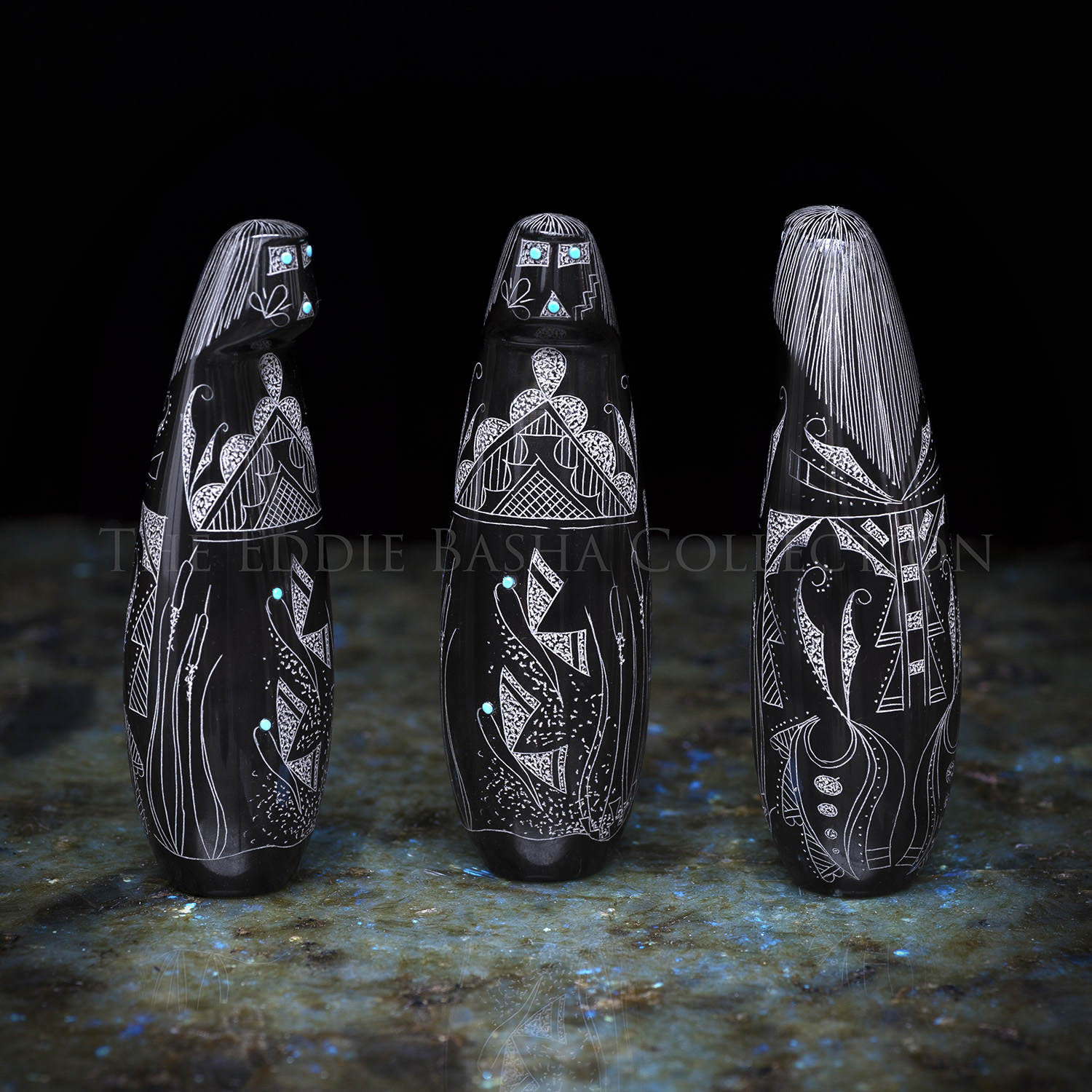
Zuni Maiden | Jonathan Natewa
Artist: American Indian Fetishes
Description: Black Marble & Turquoise | Dimensions: 4 ¼”h x 1 ¼”w x 1 ¼”dsculpture
To do this sgraffito designed black marble Zuni Maiden by Jonathan Natewa justice, three image perspectives are shown. The sgraffito technique is made by scratching through a surface to reveal the contrasting color below.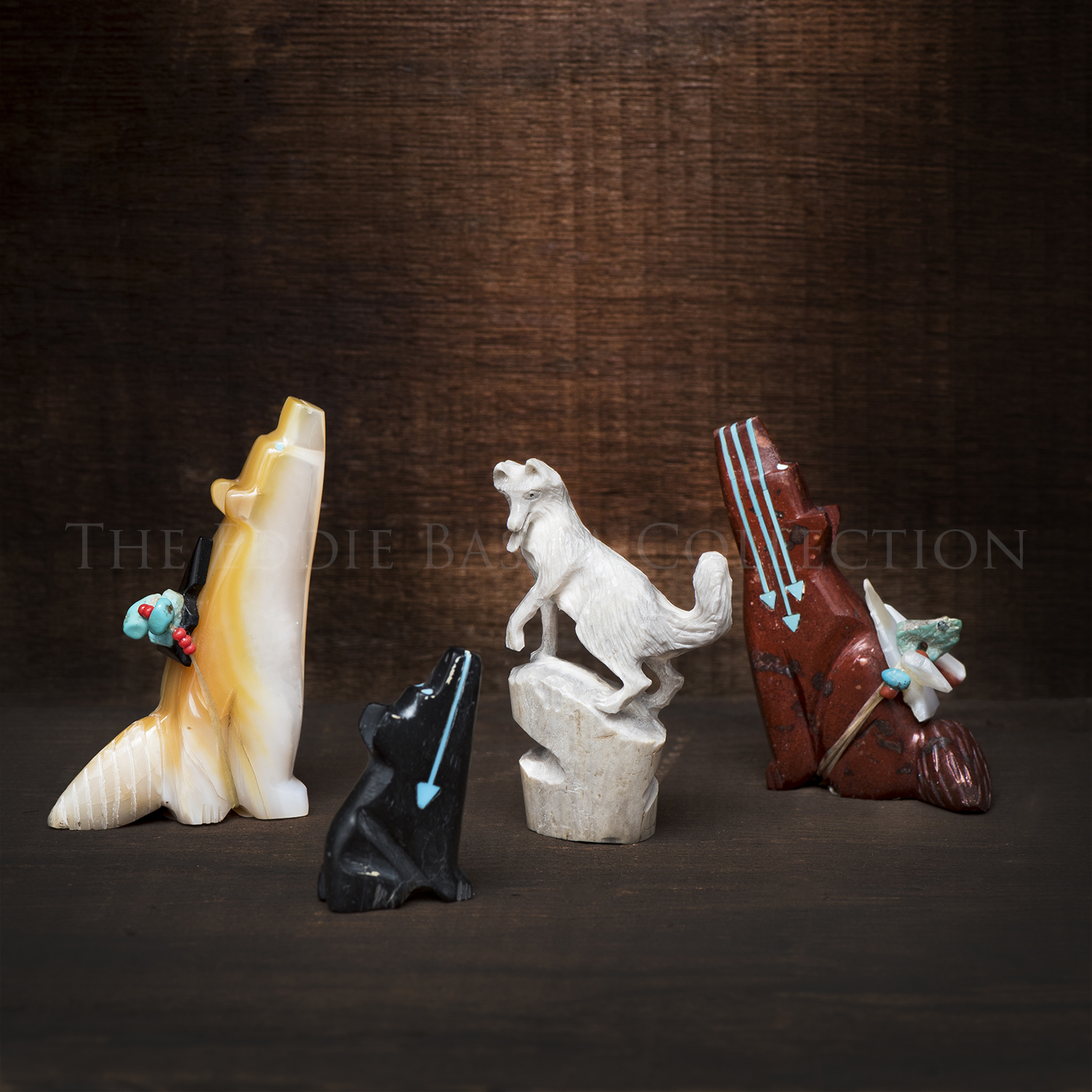
Coyote Fetishes | Zuni Artisans
Artist: American Indian Fetishes
Description: The coyote symbolizes a hunting animal and master trickster representing humor, foolishness, and the ability to laugh at one’s own foibles. And though the coyote can be arrogant and self-serving, the lesson to be learned is to recognize one’s own bad habits. They do, however, bring the gifts of survival skills, reversal of fortune and adaptation to the unpredictability of life reminding us to live in the moment.sculpture
The majority of fetishes in the collection were acquired from the artists directly or from Turquoise Village in Zuni Pueblo, New Mexico.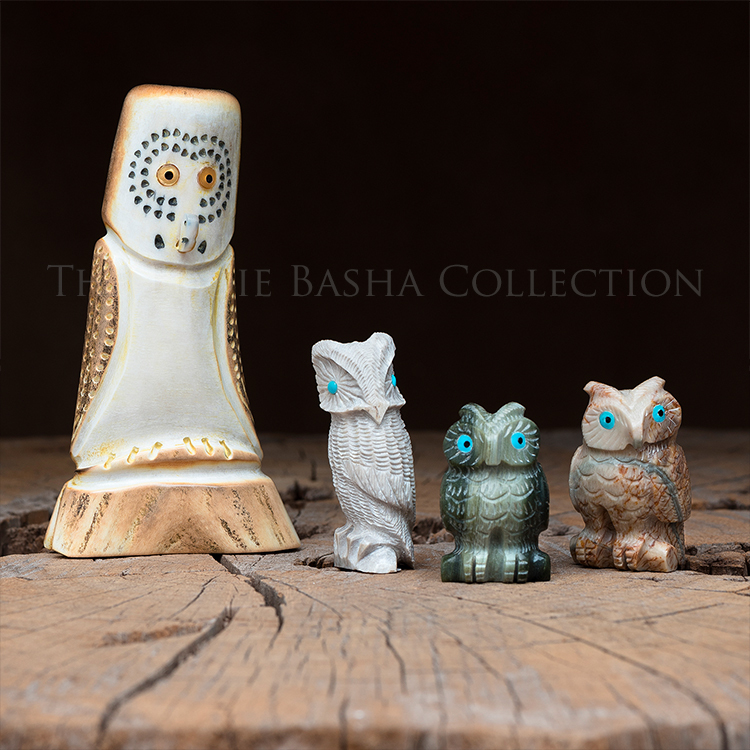
Owl Fetishes
Artist: American Indian Fetishes
Description:sculpture
Left to Right:
Howard Lasarlby (Antler)
Willard Laate (Elk Antler w/Turquoise eyes)
Unknown Carver/Horned Owl (Green Serpentine w/Turquoise eyes)
Unknown Carver/Horned Owl (Picasso Marble w/Turquoise eyes)
In the Zuni culture, the owl is the protector of the home and the keeper of the night. He is able to see what others cannot see and is thought to be very observant, perceptive, have true wisdom and patience. He controls the dark side of nature.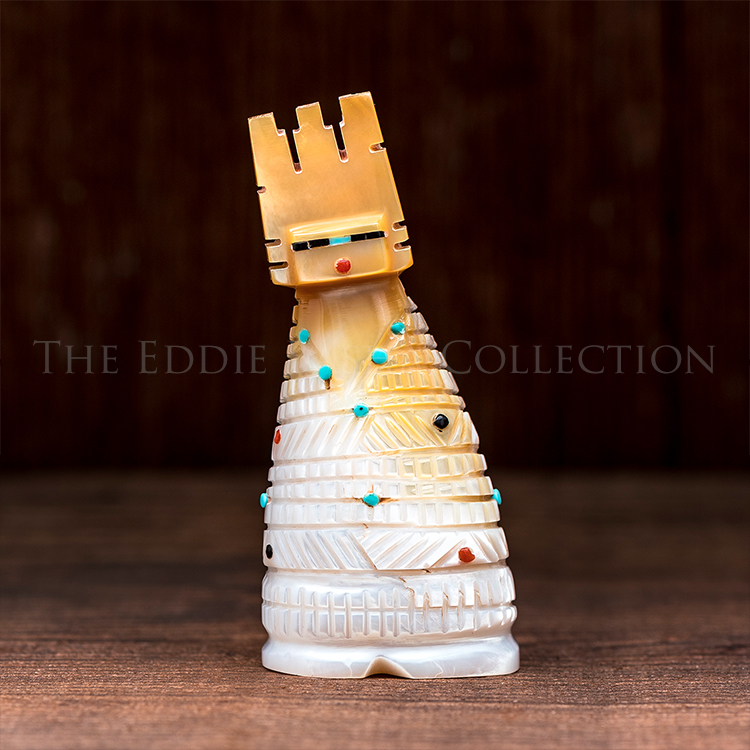
Zuni Corn Maiden Fetish | Carl Etsate
Artist: American Indian Fetishes
Description: Mother of Pearl | Dimensions: 2”h x 1”wsculpture
Zuni artist Carl Etsate who is well known for his work, in particular his Corn Maiden fetishes, and his use of various shell materials carved this diminutive, 2” x 1”, beauty out of Mother of Pearl and added turquoise, jet and coral inlay accent details. The Corn Maiden is revered for her generosity by bringing food and other offerings to the spring ceremonies as well as good fortune. She is beloved and appears in many Zuni art forms and that of other American Indian cultures.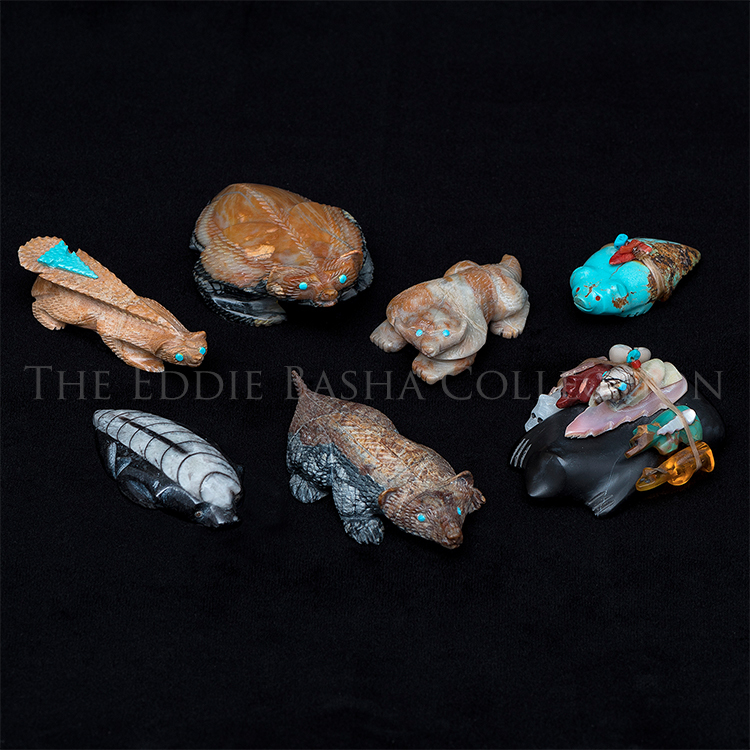
Zuni Badger Fetish
Artist: American Indian Fetishes
Description: The Zuni culture believes that a fetish is representative of an animal’s spirit which resides in the stone. The Badger is a guardian and master of the South that has great knowledge of the earth, understands agriculture and is thought to also have knowledge of healing roots and herbs because he live close to the ground. The badger is fierce, tenacious, bold, persistent, and known to overcome larger animals. Thusly, it can be depended upon in difficult situations. Badgers are healers and protectors.sculpture
Zuni Snake Fetish
Artist: American Indian Fetishes
Description: In the Zuni culture and in Zuni ceremonies, snakes represent energy and aid in the connection with greater powers. It symbolizes life, death, and rebirth, is believed to have curative powers and is also associated with lightning.sculpture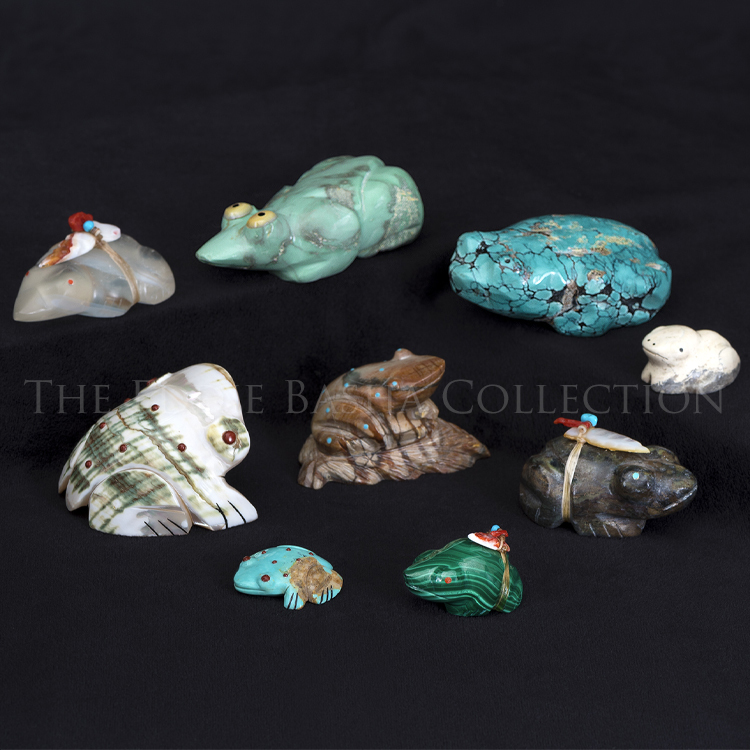
Zuni Frog Fetish | Various Artists
Artist: American Indian Fetishes
Description: Since we’ve been experiencing a lot of rain in the Desert Southwest during the Fall 2019, we thought it apropos to highlight a few of the Zuni frog fetishes which are associated with rain and water. Frogs and tadpoles also represent the cycle of life; hence the frog is also the fertility fetish.sculpture
“In this context, the word fetish refers to a small charm or talisman carved by hand from various materials such as stone, mineral, wood, bone, antler or fossil. Fetishes have existed in one form or another all over the world in various ancient cultures since before the beginning of time. The existence of fetishes today is reserved primarily as an expression of tribal art and beauty rather than serving the practical yet superstitious role they have in the past.
Today, the Zuni Tribe of northern New Mexico remains the primary producer of fetish carvings in Native American culture. These small fetish carvings have been believed by the Zuni Tribe to hold protective and/or healing powers and specific animals were also known to provide luck in hunting game. Zuni fetishes can be thought of as objects holding a spiritual significance that can provide supernatural support if treated by the owner with the necessary respect. Owners or Zuni fetishes range from enthusiastic collectors who admire these small carvings as breathtaking works or art to those seeking the special powers believed to be held within. Whatever your intended purpose, one thing is for certain: it's easy to love and cherish these tiny native carvings.”
Source: Turquoise Village in Zuni, New Mexico
Fetish Necklaces | Dinah and Peter Gasper, Sr.
Artist: American Indian Fetishes
Description: Fossilized Ivory w/ Heishi | 3 Strands Each, 16”jewelry
Dinah (b.1944) and Peter Gasper, Sr. (1938-2012) collaborated as an award-winning husband and wife team creating finely carved animal, bird and fish fetish, as necklaces and as standalone pieces. They are credited as being the first Zuni carvers to incorporate the heartline symbol representing the breath of life force of an animal as well as developing a silver tag with their personalized hallmark applied that identified their work. Shown here, the two fossilized ivory fetish necklaces with brown heishi, three strands each, include the Gasper silver hallmark.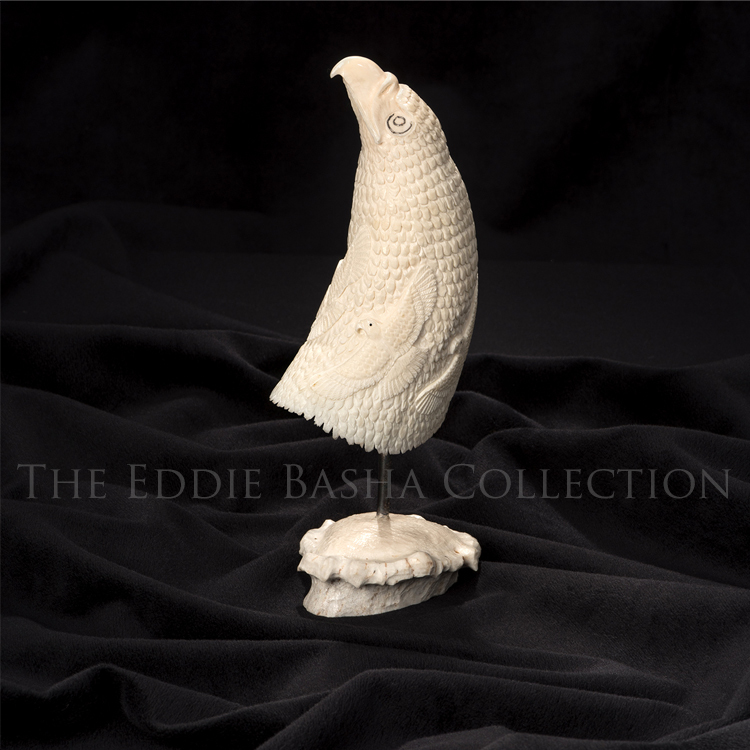
Eagle | Esteban Najera
Artist: American Indian Fetishes
Description: Antler Carved Zuni Fetish | 7”h x 3”wsculpture
According to the Zuni, fetishes, or animal depictions, house the spirit or supernatural qualities of animals only after they have been blessed by the tribal Medicine Society at the winter solstice gathering. If they are properly cared for and nurtured they may bring special power to the people who use them. They also believe there are six primary directions: north, east, south, west, upward, and downward. The Eagle is the messenger to the gods and represents power, balance, dignity, vision, higher truth, and grace. The eagle is found in both the healing and small game hunting directions.
Zuni artist, Esteban Najera, displays expert knowledge of anatomy when his carvings emerge. His antler bird carvings are so wonderful and delicate that it seems that the Zuni spirits have guided him. He started carving around 1990.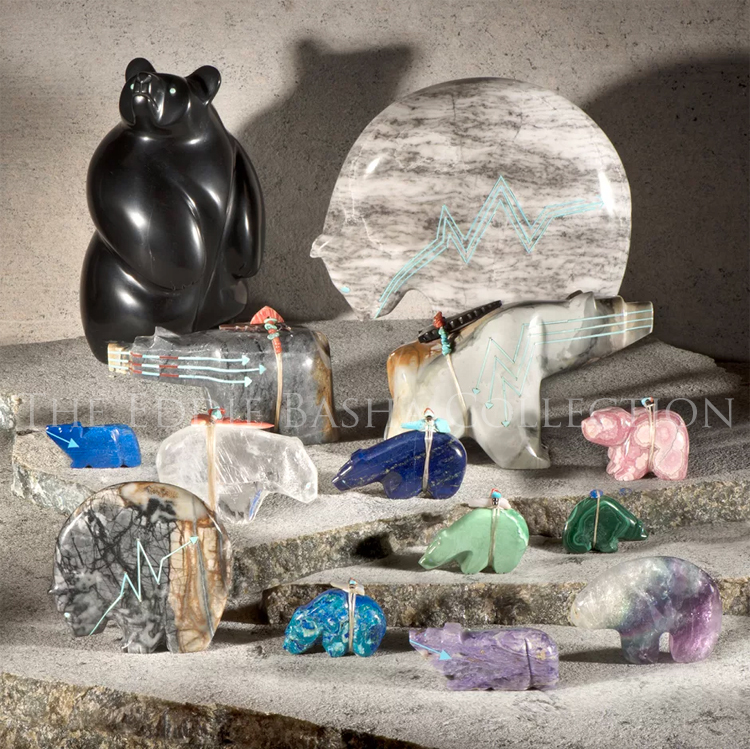
Fetish Assortment
Artist: American Indian Fetishes
sculpture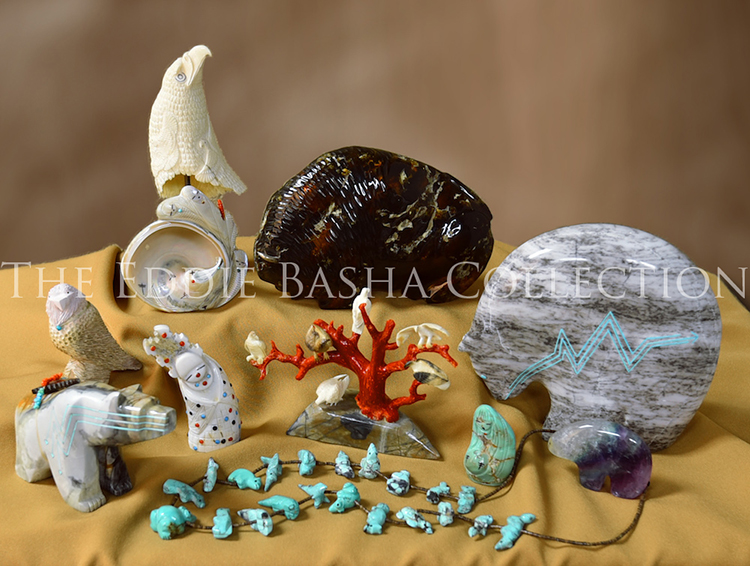
Fetish Assortment
Artist: American Indian Fetishes
sculpture
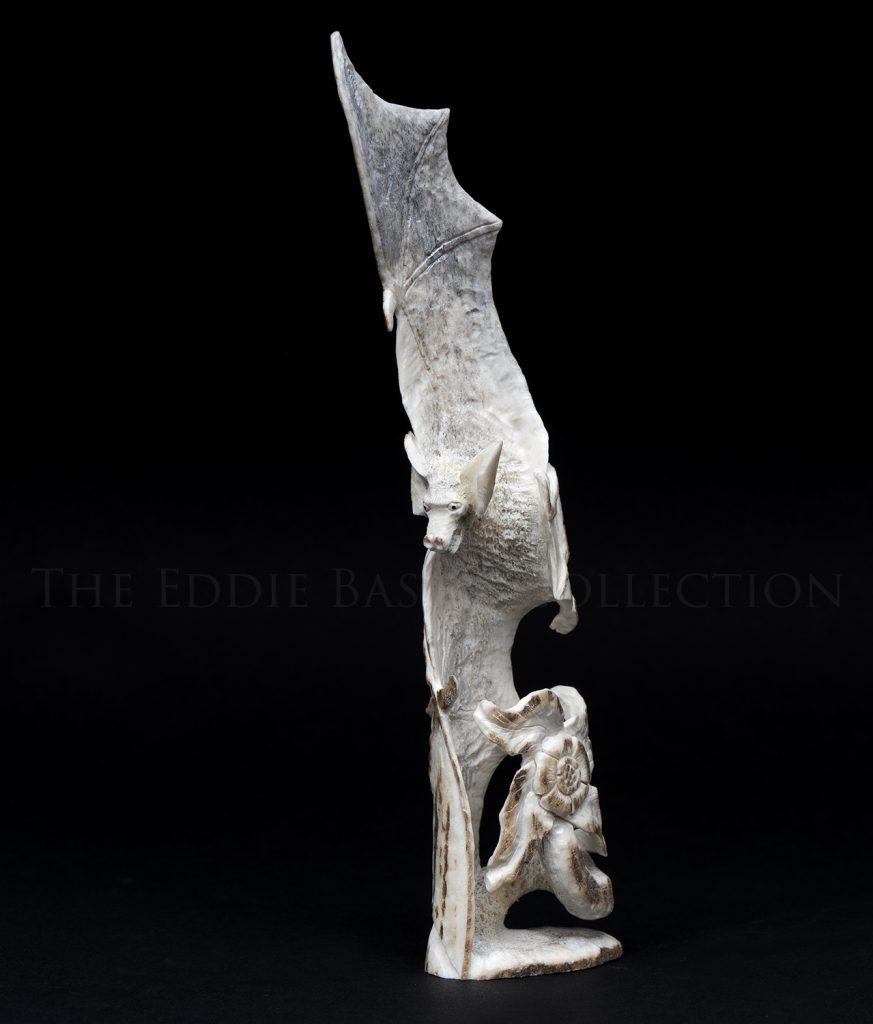 Antler Carving | 7 ¾”h x 1 ¾”w x 1”d
Antler Carving | 7 ¾”h x 1 ¾”w x 1”dCarved from antler, the bat is known as being the guardian of the night, the cleaner, in Zuni culture.
Bat Fetish | Lewis Malie
Artist: American Indian Fetishes
Description:
Antler Carving | 7 ¾”h x 1 ¾”w x 1”d
Carved from antler, the bat is known as being the guardian of the night, the cleaner, in Zuni culture.
sculptureCarved from antler, the bat is known as being the guardian of the night, the cleaner, in Zuni culture.
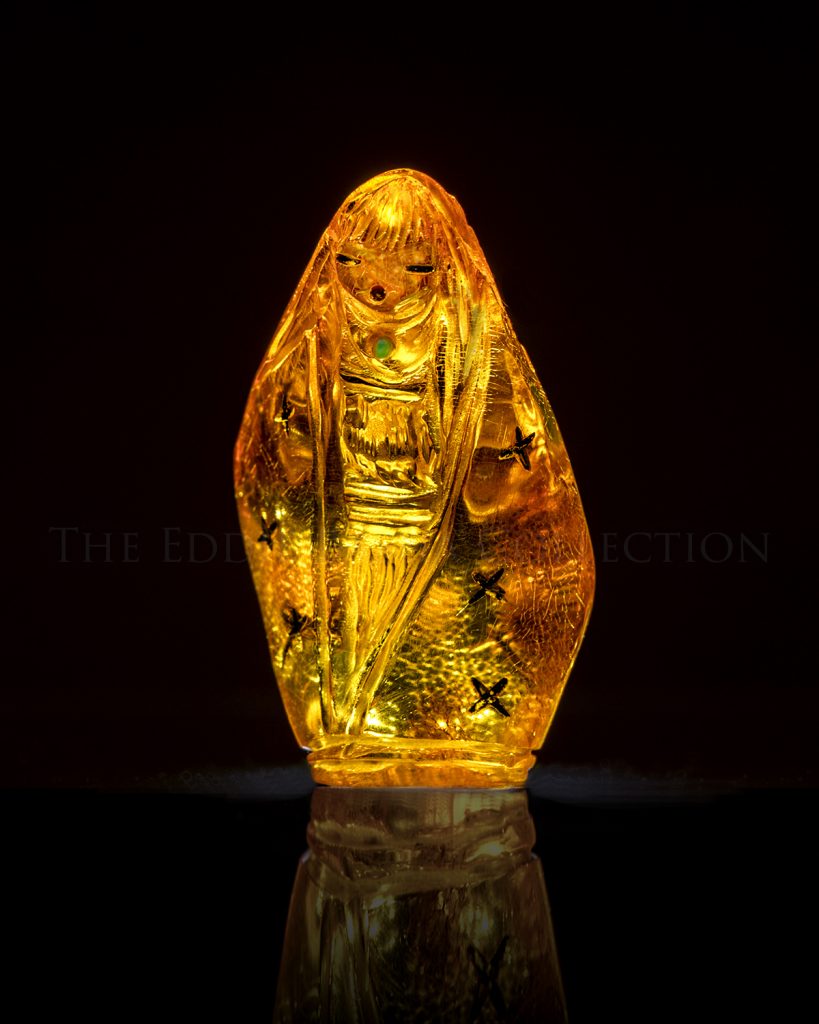 Amber | Dimensions: 3”h
Amber | Dimensions: 3”hFaye Quandelacy, the internationally renowned Zuni fetish carver who graduated from the Institute of American Indian Arts in Santa Fe where she studied under Allan Houser, passed away September 2022. Quandelacy is credited for pioneering a very unique style of maiden carvings such as the beautiful amber piece shown here. Faye passed on her many gifts to her daughter just as her Mother, Ellen Quandelacy, passed on her gifts to Faye.
Zuni Maiden | Faye Quandelacy (1958-2022)
Artist: American Indian Fetishes
Description:
Amber | Dimensions: 3”h
Faye Quandelacy, the internationally renowned Zuni fetish carver who graduated from the Institute of American Indian Arts in Santa Fe where she studied under Allan Houser, passed away September 2022. Quandelacy is credited for pioneering a very unique style of maiden carvings such as the beautiful amber piece shown here. Faye passed on her many gifts to her daughter just as her Mother, Ellen Quandelacy, passed on her gifts to Faye.
sculptureFaye Quandelacy, the internationally renowned Zuni fetish carver who graduated from the Institute of American Indian Arts in Santa Fe where she studied under Allan Houser, passed away September 2022. Quandelacy is credited for pioneering a very unique style of maiden carvings such as the beautiful amber piece shown here. Faye passed on her many gifts to her daughter just as her Mother, Ellen Quandelacy, passed on her gifts to Faye.
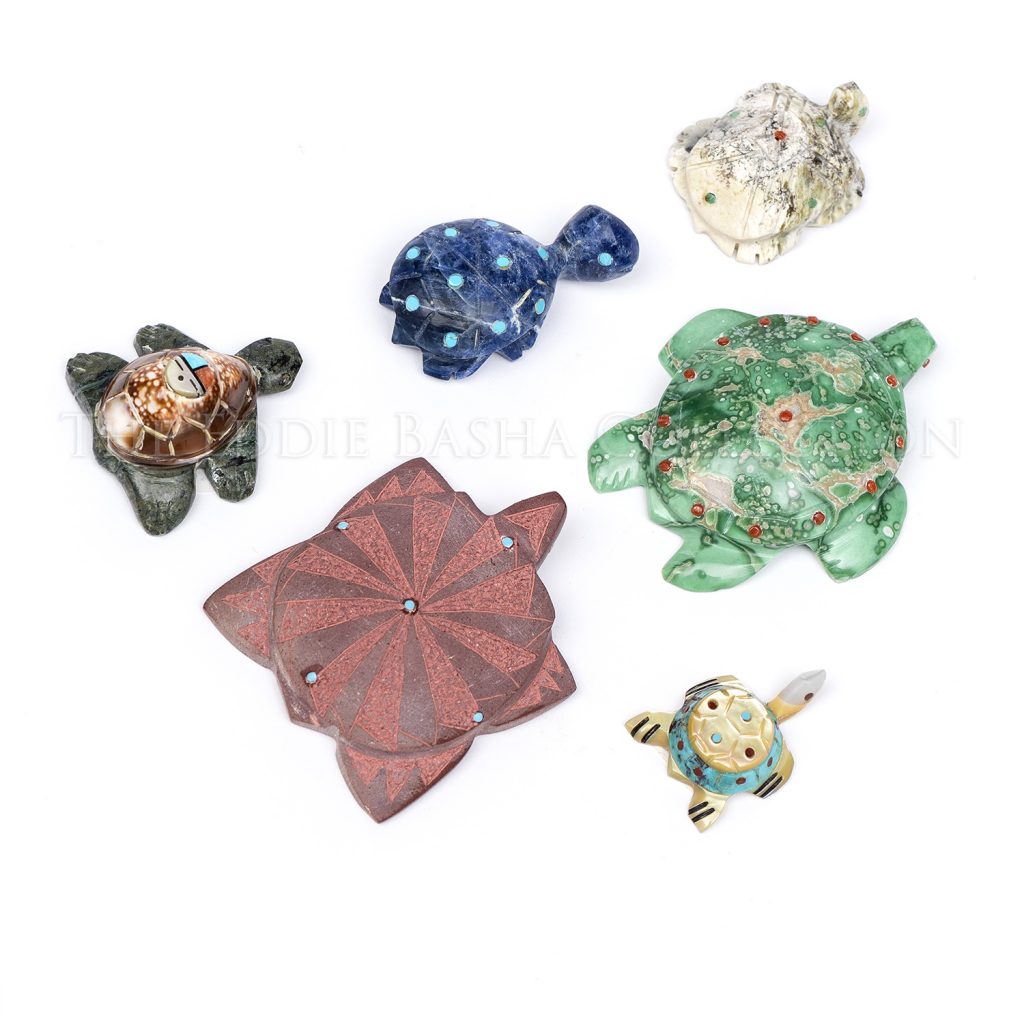 The turtle fetish, a symbol of Mother Earth, is one of the most frequently carved Zuni fetishes. It serves as a link to Zuni ancestors and is associated with longevity, tenacity and self-reliance.
The turtle fetish, a symbol of Mother Earth, is one of the most frequently carved Zuni fetishes. It serves as a link to Zuni ancestors and is associated with longevity, tenacity and self-reliance. The names of the carvers and the materials used pictured here are as follows beginning at the center top, then rotating clockwise:
Loren Burns: Lapis (Blue) Turtle
Carl Etsate: Serpentine Turtle
Chris Huselew: Varasite (Green) Turtle
Loren Burns: Mother of Pearl & Turquoise Mop Turtle
Brandon Phillips: Pipestone Etched Turtle
Fabian Homer: Cowrie Shell & Marble Turtle with Zuni Sun Face
Zuni Turtle Fetish | Various Artists
Artist: American Indian Fetishes
Description:
The turtle fetish, a symbol of Mother Earth, is one of the most frequently carved Zuni fetishes. It serves as a link to Zuni ancestors and is associated with longevity, tenacity and self-reliance.
The names of the carvers and the materials used pictured here are as follows beginning at the center top, then rotating clockwise:
Loren Burns: Lapis (Blue) Turtle
Carl Etsate: Serpentine Turtle
Chris Huselew: Varasite (Green) Turtle
Loren Burns: Mother of Pearl & Turquoise Mop Turtle
Brandon Phillips: Pipestone Etched Turtle
Fabian Homer: Cowrie Shell & Marble Turtle with Zuni Sun Face
sculptureThe names of the carvers and the materials used pictured here are as follows beginning at the center top, then rotating clockwise:
Loren Burns: Lapis (Blue) Turtle
Carl Etsate: Serpentine Turtle
Chris Huselew: Varasite (Green) Turtle
Loren Burns: Mother of Pearl & Turquoise Mop Turtle
Brandon Phillips: Pipestone Etched Turtle
Fabian Homer: Cowrie Shell & Marble Turtle with Zuni Sun Face
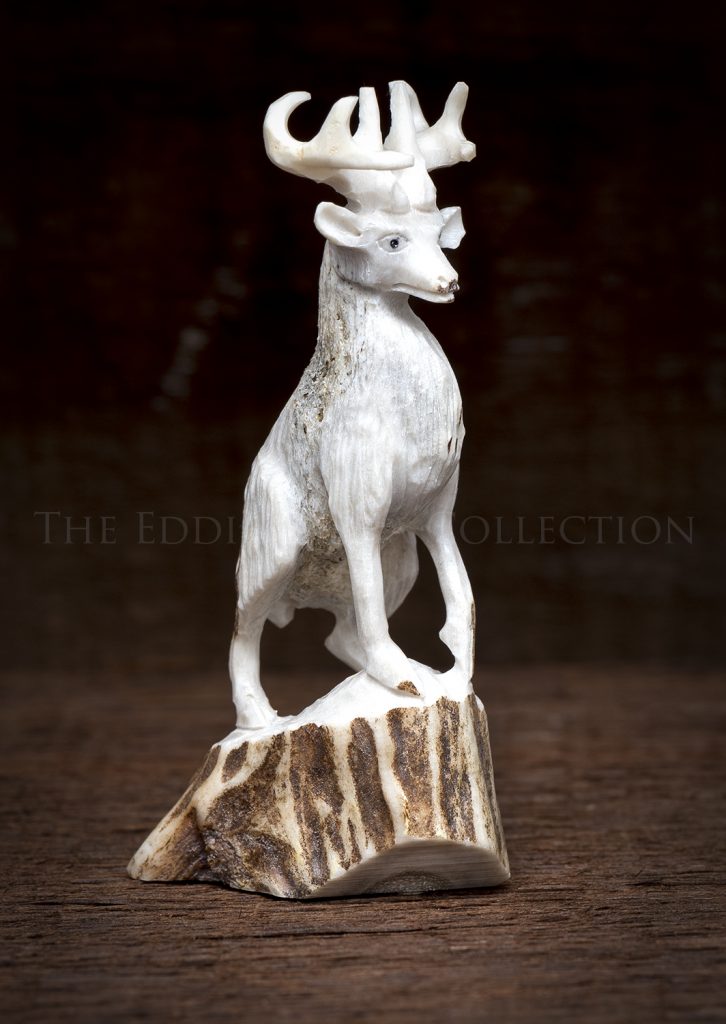 Deer Antler | Dimensions: 2 ½”h x 2 ½”w
Deer Antler | Dimensions: 2 ½”h x 2 ½”wIn Zuni culture, deer represent gentleness, compassion and kindness and though deer are less commonly carved, they are often depicted with a fair amount of attention to detail and carved in deer antler as is the case here. This particular fetish was carved by the late Pernell Laate who was a wonderful Zuni carver of human figures, birds and other animal fetishes. He often used antler and fossilized ivory to create intricate and delicate carvings. Pernell began carving in the middle 1980s along with his brother, Max Pernell.
Deer Fetish | Pernell Laate (d.2008)
Artist: American Indian Fetishes
Description:
Deer Antler | Dimensions: 2 ½”h x 2 ½”w
In Zuni culture, deer represent gentleness, compassion and kindness and though deer are less commonly carved, they are often depicted with a fair amount of attention to detail and carved in deer antler as is the case here. This particular fetish was carved by the late Pernell Laate who was a wonderful Zuni carver of human figures, birds and other animal fetishes. He often used antler and fossilized ivory to create intricate and delicate carvings. Pernell began carving in the middle 1980s along with his brother, Max Pernell.
sculptureIn Zuni culture, deer represent gentleness, compassion and kindness and though deer are less commonly carved, they are often depicted with a fair amount of attention to detail and carved in deer antler as is the case here. This particular fetish was carved by the late Pernell Laate who was a wonderful Zuni carver of human figures, birds and other animal fetishes. He often used antler and fossilized ivory to create intricate and delicate carvings. Pernell began carving in the middle 1980s along with his brother, Max Pernell.
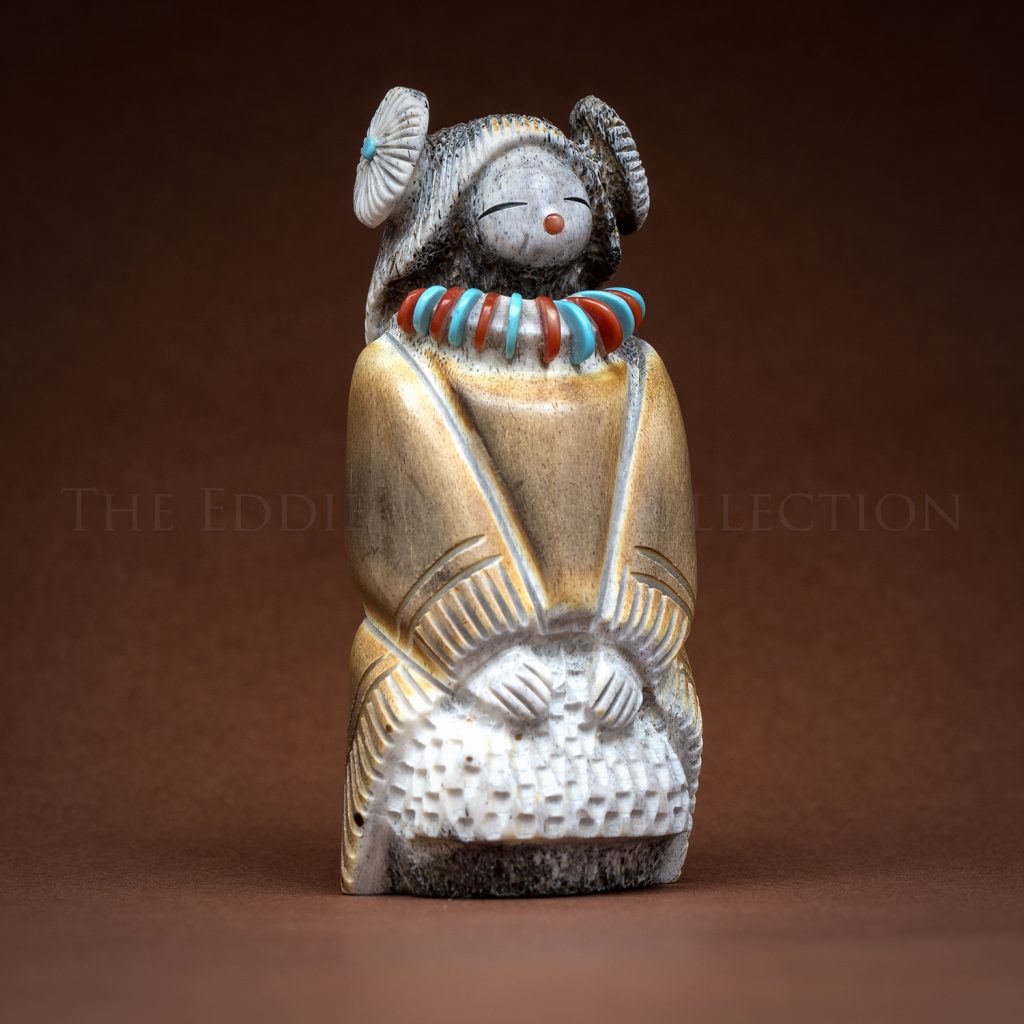 Elk Antler, turquoise & coral | Dimensions: 2 ¾”h x 1 ½”w x 1 ½”d
Elk Antler, turquoise & coral | Dimensions: 2 ¾”h x 1 ½”w x 1 ½”dZuni fetish carver Claudia Peina carves unique pieces such as warrior, Hopi, corn and olla maidens, priests, angels, bread makers as well as frogs, cats, rabbits turtles, owls and bears. Her pieces reflect her personality exhibiting happiness, freedom and carefreeness. Numerous family members have been her mentors through the years and she in turn has mentored others.
At the onset of carving, Claudia spends a few silent moments to allow her creativity to flow. Her carvings are unique, imaginative and bring a great deal of joy to those who acquire them. She has created a series of standing bears affectionately called “Good News Bears” displaying various attitudes and poses.
Robed Hopi Maiden | Claudia Peina
Artist: American Indian Fetishes
Description:
Elk Antler, turquoise & coral | Dimensions: 2 ¾”h x 1 ½”w x 1 ½”d
Zuni fetish carver Claudia Peina carves unique pieces such as warrior, Hopi, corn and olla maidens, priests, angels, bread makers as well as frogs, cats, rabbits turtles, owls and bears. Her pieces reflect her personality exhibiting happiness, freedom and carefreeness. Numerous family members have been her mentors through the years and she in turn has mentored others.
At the onset of carving, Claudia spends a few silent moments to allow her creativity to flow. Her carvings are unique, imaginative and bring a great deal of joy to those who acquire them. She has created a series of standing bears affectionately called “Good News Bears” displaying various attitudes and poses.
sculptureZuni fetish carver Claudia Peina carves unique pieces such as warrior, Hopi, corn and olla maidens, priests, angels, bread makers as well as frogs, cats, rabbits turtles, owls and bears. Her pieces reflect her personality exhibiting happiness, freedom and carefreeness. Numerous family members have been her mentors through the years and she in turn has mentored others.
At the onset of carving, Claudia spends a few silent moments to allow her creativity to flow. Her carvings are unique, imaginative and bring a great deal of joy to those who acquire them. She has created a series of standing bears affectionately called “Good News Bears” displaying various attitudes and poses.
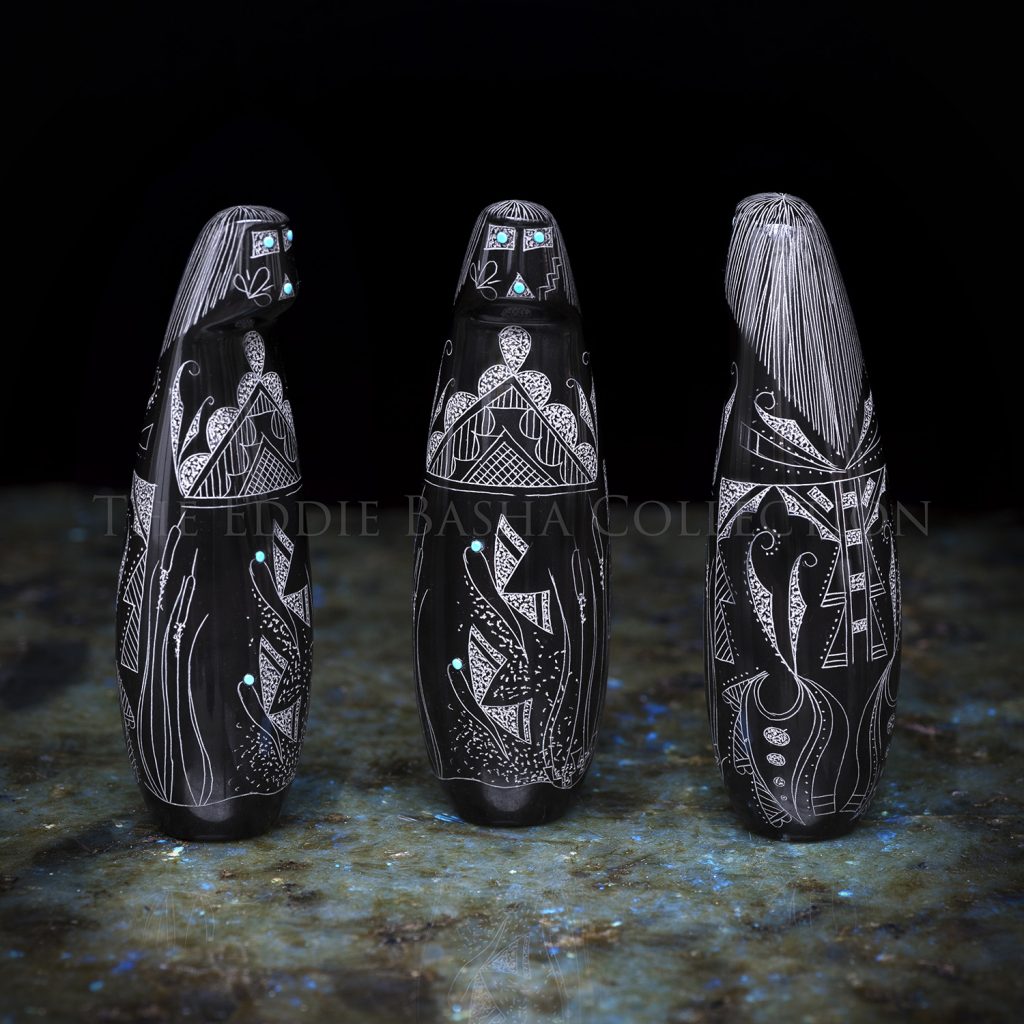 Black Marble & Turquoise | Dimensions: 4 ¼”h x 1 ¼”w x 1 ¼”d
Black Marble & Turquoise | Dimensions: 4 ¼”h x 1 ¼”w x 1 ¼”dTo do this sgraffito designed black marble Zuni Maiden by Jonathan Natewa justice, three image perspectives are shown. The sgraffito technique is made by scratching through a surface to reveal the contrasting color below.
Zuni Maiden | Jonathan Natewa
Artist: American Indian Fetishes
Description:
Black Marble & Turquoise | Dimensions: 4 ¼”h x 1 ¼”w x 1 ¼”d
To do this sgraffito designed black marble Zuni Maiden by Jonathan Natewa justice, three image perspectives are shown. The sgraffito technique is made by scratching through a surface to reveal the contrasting color below.
sculptureTo do this sgraffito designed black marble Zuni Maiden by Jonathan Natewa justice, three image perspectives are shown. The sgraffito technique is made by scratching through a surface to reveal the contrasting color below.
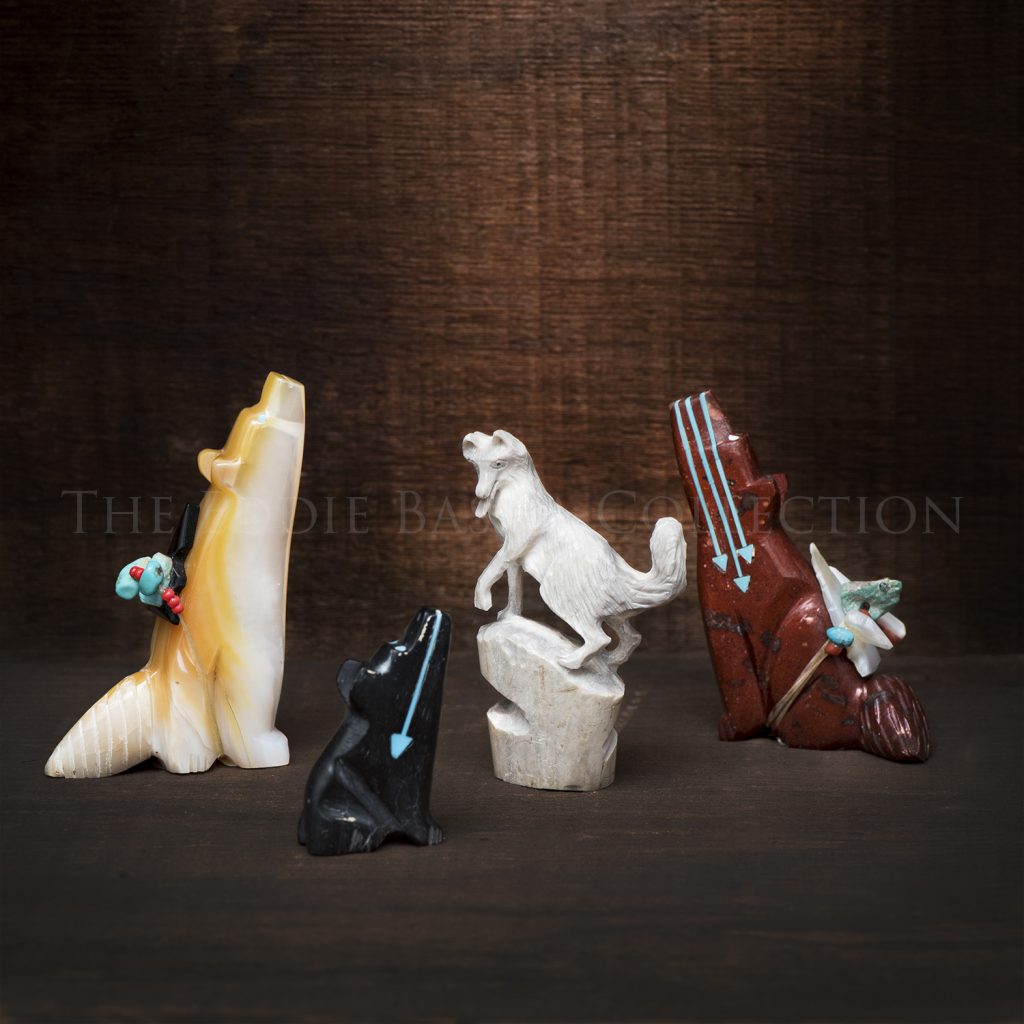 The coyote symbolizes a hunting animal and master trickster representing humor, foolishness, and the ability to laugh at one’s own foibles. And though the coyote can be arrogant and self-serving, the lesson to be learned is to recognize one’s own bad habits. They do, however, bring the gifts of survival skills, reversal of fortune and adaptation to the unpredictability of life reminding us to live in the moment.
The coyote symbolizes a hunting animal and master trickster representing humor, foolishness, and the ability to laugh at one’s own foibles. And though the coyote can be arrogant and self-serving, the lesson to be learned is to recognize one’s own bad habits. They do, however, bring the gifts of survival skills, reversal of fortune and adaptation to the unpredictability of life reminding us to live in the moment. The majority of fetishes in the collection were acquired from the artists directly or from Turquoise Village in Zuni Pueblo, New Mexico.
Coyote Fetishes | Zuni Artisans
Artist: American Indian Fetishes
Description:
The coyote symbolizes a hunting animal and master trickster representing humor, foolishness, and the ability to laugh at one’s own foibles. And though the coyote can be arrogant and self-serving, the lesson to be learned is to recognize one’s own bad habits. They do, however, bring the gifts of survival skills, reversal of fortune and adaptation to the unpredictability of life reminding us to live in the moment.
The majority of fetishes in the collection were acquired from the artists directly or from Turquoise Village in Zuni Pueblo, New Mexico.
sculptureThe majority of fetishes in the collection were acquired from the artists directly or from Turquoise Village in Zuni Pueblo, New Mexico.

Left to Right:
Howard Lasarlby (Antler)
Willard Laate (Elk Antler w/Turquoise eyes)
Unknown Carver/Horned Owl (Green Serpentine w/Turquoise eyes)
Unknown Carver/Horned Owl (Picasso Marble w/Turquoise eyes)
In the Zuni culture, the owl is the protector of the home and the keeper of the night. He is able to see what others cannot see and is thought to be very observant, perceptive, have true wisdom and patience. He controls the dark side of nature.
Owl Fetishes
Artist: American Indian Fetishes
Description:
Left to Right:
Howard Lasarlby (Antler)
Willard Laate (Elk Antler w/Turquoise eyes)
Unknown Carver/Horned Owl (Green Serpentine w/Turquoise eyes)
Unknown Carver/Horned Owl (Picasso Marble w/Turquoise eyes)
In the Zuni culture, the owl is the protector of the home and the keeper of the night. He is able to see what others cannot see and is thought to be very observant, perceptive, have true wisdom and patience. He controls the dark side of nature.
sculptureLeft to Right:
Howard Lasarlby (Antler)
Willard Laate (Elk Antler w/Turquoise eyes)
Unknown Carver/Horned Owl (Green Serpentine w/Turquoise eyes)
Unknown Carver/Horned Owl (Picasso Marble w/Turquoise eyes)
In the Zuni culture, the owl is the protector of the home and the keeper of the night. He is able to see what others cannot see and is thought to be very observant, perceptive, have true wisdom and patience. He controls the dark side of nature.
 Mother of Pearl | Dimensions: 2”h x 1”w
Mother of Pearl | Dimensions: 2”h x 1”wZuni artist Carl Etsate who is well known for his work, in particular his Corn Maiden fetishes, and his use of various shell materials carved this diminutive, 2” x 1”, beauty out of Mother of Pearl and added turquoise, jet and coral inlay accent details. The Corn Maiden is revered for her generosity by bringing food and other offerings to the spring ceremonies as well as good fortune. She is beloved and appears in many Zuni art forms and that of other American Indian cultures.
Zuni Corn Maiden Fetish | Carl Etsate
Artist: American Indian Fetishes
Description:
Mother of Pearl | Dimensions: 2”h x 1”w
Zuni artist Carl Etsate who is well known for his work, in particular his Corn Maiden fetishes, and his use of various shell materials carved this diminutive, 2” x 1”, beauty out of Mother of Pearl and added turquoise, jet and coral inlay accent details. The Corn Maiden is revered for her generosity by bringing food and other offerings to the spring ceremonies as well as good fortune. She is beloved and appears in many Zuni art forms and that of other American Indian cultures.
sculptureZuni artist Carl Etsate who is well known for his work, in particular his Corn Maiden fetishes, and his use of various shell materials carved this diminutive, 2” x 1”, beauty out of Mother of Pearl and added turquoise, jet and coral inlay accent details. The Corn Maiden is revered for her generosity by bringing food and other offerings to the spring ceremonies as well as good fortune. She is beloved and appears in many Zuni art forms and that of other American Indian cultures.
 The Zuni culture believes that a fetish is representative of an animal’s spirit which resides in the stone. The Badger is a guardian and master of the South that has great knowledge of the earth, understands agriculture and is thought to also have knowledge of healing roots and herbs because he live close to the ground. The badger is fierce, tenacious, bold, persistent, and known to overcome larger animals. Thusly, it can be depended upon in difficult situations. Badgers are healers and protectors.
The Zuni culture believes that a fetish is representative of an animal’s spirit which resides in the stone. The Badger is a guardian and master of the South that has great knowledge of the earth, understands agriculture and is thought to also have knowledge of healing roots and herbs because he live close to the ground. The badger is fierce, tenacious, bold, persistent, and known to overcome larger animals. Thusly, it can be depended upon in difficult situations. Badgers are healers and protectors. Zuni Badger Fetish
Artist: American Indian Fetishes
Description:
The Zuni culture believes that a fetish is representative of an animal’s spirit which resides in the stone. The Badger is a guardian and master of the South that has great knowledge of the earth, understands agriculture and is thought to also have knowledge of healing roots and herbs because he live close to the ground. The badger is fierce, tenacious, bold, persistent, and known to overcome larger animals. Thusly, it can be depended upon in difficult situations. Badgers are healers and protectors.
sculpture In the Zuni culture and in Zuni ceremonies, snakes represent energy and aid in the connection with greater powers. It symbolizes life, death, and rebirth, is believed to have curative powers and is also associated with lightning.
In the Zuni culture and in Zuni ceremonies, snakes represent energy and aid in the connection with greater powers. It symbolizes life, death, and rebirth, is believed to have curative powers and is also associated with lightning. Zuni Snake Fetish
Artist: American Indian Fetishes
Description:
In the Zuni culture and in Zuni ceremonies, snakes represent energy and aid in the connection with greater powers. It symbolizes life, death, and rebirth, is believed to have curative powers and is also associated with lightning.
sculpture Since we’ve been experiencing a lot of rain in the Desert Southwest during the Fall 2019, we thought it apropos to highlight a few of the Zuni frog fetishes which are associated with rain and water. Frogs and tadpoles also represent the cycle of life; hence the frog is also the fertility fetish.
Since we’ve been experiencing a lot of rain in the Desert Southwest during the Fall 2019, we thought it apropos to highlight a few of the Zuni frog fetishes which are associated with rain and water. Frogs and tadpoles also represent the cycle of life; hence the frog is also the fertility fetish. “In this context, the word fetish refers to a small charm or talisman carved by hand from various materials such as stone, mineral, wood, bone, antler or fossil. Fetishes have existed in one form or another all over the world in various ancient cultures since before the beginning of time. The existence of fetishes today is reserved primarily as an expression of tribal art and beauty rather than serving the practical yet superstitious role they have in the past.
Today, the Zuni Tribe of northern New Mexico remains the primary producer of fetish carvings in Native American culture. These small fetish carvings have been believed by the Zuni Tribe to hold protective and/or healing powers and specific animals were also known to provide luck in hunting game. Zuni fetishes can be thought of as objects holding a spiritual significance that can provide supernatural support if treated by the owner with the necessary respect. Owners or Zuni fetishes range from enthusiastic collectors who admire these small carvings as breathtaking works or art to those seeking the special powers believed to be held within. Whatever your intended purpose, one thing is for certain: it's easy to love and cherish these tiny native carvings.”
Source: Turquoise Village in Zuni, New Mexico
Zuni Frog Fetish | Various Artists
Artist: American Indian Fetishes
Description:
Since we’ve been experiencing a lot of rain in the Desert Southwest during the Fall 2019, we thought it apropos to highlight a few of the Zuni frog fetishes which are associated with rain and water. Frogs and tadpoles also represent the cycle of life; hence the frog is also the fertility fetish.
“In this context, the word fetish refers to a small charm or talisman carved by hand from various materials such as stone, mineral, wood, bone, antler or fossil. Fetishes have existed in one form or another all over the world in various ancient cultures since before the beginning of time. The existence of fetishes today is reserved primarily as an expression of tribal art and beauty rather than serving the practical yet superstitious role they have in the past.
Today, the Zuni Tribe of northern New Mexico remains the primary producer of fetish carvings in Native American culture. These small fetish carvings have been believed by the Zuni Tribe to hold protective and/or healing powers and specific animals were also known to provide luck in hunting game. Zuni fetishes can be thought of as objects holding a spiritual significance that can provide supernatural support if treated by the owner with the necessary respect. Owners or Zuni fetishes range from enthusiastic collectors who admire these small carvings as breathtaking works or art to those seeking the special powers believed to be held within. Whatever your intended purpose, one thing is for certain: it's easy to love and cherish these tiny native carvings.”
Source: Turquoise Village in Zuni, New Mexico
sculpture“In this context, the word fetish refers to a small charm or talisman carved by hand from various materials such as stone, mineral, wood, bone, antler or fossil. Fetishes have existed in one form or another all over the world in various ancient cultures since before the beginning of time. The existence of fetishes today is reserved primarily as an expression of tribal art and beauty rather than serving the practical yet superstitious role they have in the past.
Today, the Zuni Tribe of northern New Mexico remains the primary producer of fetish carvings in Native American culture. These small fetish carvings have been believed by the Zuni Tribe to hold protective and/or healing powers and specific animals were also known to provide luck in hunting game. Zuni fetishes can be thought of as objects holding a spiritual significance that can provide supernatural support if treated by the owner with the necessary respect. Owners or Zuni fetishes range from enthusiastic collectors who admire these small carvings as breathtaking works or art to those seeking the special powers believed to be held within. Whatever your intended purpose, one thing is for certain: it's easy to love and cherish these tiny native carvings.”
Source: Turquoise Village in Zuni, New Mexico
 Fossilized Ivory w/ Heishi | 3 Strands Each, 16”
Fossilized Ivory w/ Heishi | 3 Strands Each, 16”Dinah (b.1944) and Peter Gasper, Sr. (1938-2012) collaborated as an award-winning husband and wife team creating finely carved animal, bird and fish fetish, as necklaces and as standalone pieces. They are credited as being the first Zuni carvers to incorporate the heartline symbol representing the breath of life force of an animal as well as developing a silver tag with their personalized hallmark applied that identified their work. Shown here, the two fossilized ivory fetish necklaces with brown heishi, three strands each, include the Gasper silver hallmark.
Fetish Necklaces | Dinah and Peter Gasper, Sr.
Artist: American Indian Fetishes
Description:
Fossilized Ivory w/ Heishi | 3 Strands Each, 16”
Dinah (b.1944) and Peter Gasper, Sr. (1938-2012) collaborated as an award-winning husband and wife team creating finely carved animal, bird and fish fetish, as necklaces and as standalone pieces. They are credited as being the first Zuni carvers to incorporate the heartline symbol representing the breath of life force of an animal as well as developing a silver tag with their personalized hallmark applied that identified their work. Shown here, the two fossilized ivory fetish necklaces with brown heishi, three strands each, include the Gasper silver hallmark.
jewelryDinah (b.1944) and Peter Gasper, Sr. (1938-2012) collaborated as an award-winning husband and wife team creating finely carved animal, bird and fish fetish, as necklaces and as standalone pieces. They are credited as being the first Zuni carvers to incorporate the heartline symbol representing the breath of life force of an animal as well as developing a silver tag with their personalized hallmark applied that identified their work. Shown here, the two fossilized ivory fetish necklaces with brown heishi, three strands each, include the Gasper silver hallmark.
 Antler Carved Zuni Fetish | 7”h x 3”w
Antler Carved Zuni Fetish | 7”h x 3”wAccording to the Zuni, fetishes, or animal depictions, house the spirit or supernatural qualities of animals only after they have been blessed by the tribal Medicine Society at the winter solstice gathering. If they are properly cared for and nurtured they may bring special power to the people who use them. They also believe there are six primary directions: north, east, south, west, upward, and downward. The Eagle is the messenger to the gods and represents power, balance, dignity, vision, higher truth, and grace. The eagle is found in both the healing and small game hunting directions.
Zuni artist, Esteban Najera, displays expert knowledge of anatomy when his carvings emerge. His antler bird carvings are so wonderful and delicate that it seems that the Zuni spirits have guided him. He started carving around 1990.
Eagle | Esteban Najera
Artist: American Indian Fetishes
Description:
Antler Carved Zuni Fetish | 7”h x 3”w
According to the Zuni, fetishes, or animal depictions, house the spirit or supernatural qualities of animals only after they have been blessed by the tribal Medicine Society at the winter solstice gathering. If they are properly cared for and nurtured they may bring special power to the people who use them. They also believe there are six primary directions: north, east, south, west, upward, and downward. The Eagle is the messenger to the gods and represents power, balance, dignity, vision, higher truth, and grace. The eagle is found in both the healing and small game hunting directions.
Zuni artist, Esteban Najera, displays expert knowledge of anatomy when his carvings emerge. His antler bird carvings are so wonderful and delicate that it seems that the Zuni spirits have guided him. He started carving around 1990.
sculptureAccording to the Zuni, fetishes, or animal depictions, house the spirit or supernatural qualities of animals only after they have been blessed by the tribal Medicine Society at the winter solstice gathering. If they are properly cared for and nurtured they may bring special power to the people who use them. They also believe there are six primary directions: north, east, south, west, upward, and downward. The Eagle is the messenger to the gods and represents power, balance, dignity, vision, higher truth, and grace. The eagle is found in both the healing and small game hunting directions.
Zuni artist, Esteban Najera, displays expert knowledge of anatomy when his carvings emerge. His antler bird carvings are so wonderful and delicate that it seems that the Zuni spirits have guided him. He started carving around 1990.